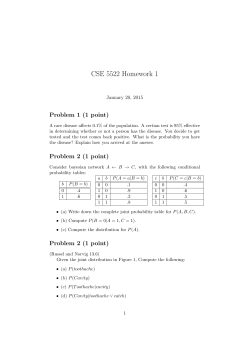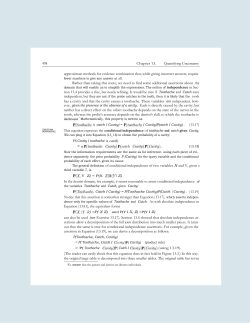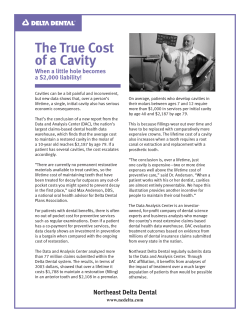
Document 403389
492
Chapter 13.
toothache
cavity
—pcavity
Quantifying Uncertainty
—toothache
catch
—'catch
catch
—, catch
0.108
0.016
0.012
0.064
0.072
0.144
0.008
0.576
A full joint distribu ion for the Toothache, Cavity, Catch world.
Figure 13.3
We begin with a simple example: a domain consisting of just the three Boolean variables
Toothache, Cavity, and Catch (the dentist's nasty steel probe catches in my tooth). The full
joint distribution is a 2 x 2 x 2 table as shown in Figure 13.3.
Notice that the probabilities in the joint distribution sum to 1, as required by the axioms
of probability. Notice also that Equation (13.2) gives us a direct way to calculate the probability of any proposition, simple or complex: simply identify those possible worlds in which the
proposition is true and add up their probabilities. For example, there are six possible worlds
in which cavity V toothache holds:
P(cavity V toothache) = 0.108 + 0.012 + 0.072 + 0.008 + 0.016 + 0.064 = 0.28
MARGINAL
PROBABILITY
One particularly common task is to extract the distribution over some subset of variables or
a single variable. For example, adding the entries in the first row gives the unconditional or
marginal probability 4 of cavity:
P(cavity) = 1).108 + 0.012 + 0.072 + 0.008 = 0.2 .
MARGI MIZATION
This process is called marginalization, or summing out—because we sum up the probabilities for each possible value of the other variables, thereby taking them out of the equation.
We can write the following general marginalization rule for any sets of variables Y and Z:
P(Y) =
E P(Y, z) ,
(13.6)
zEZ
where Ezez means to sum over all the possible combinations of values of the set of variables
Z. We sometimes abbreviate this as z leaving Z implicit. We just used the rule as
r,
P( Cavity ,z) .
(13.7)
ze { Cach, Teo tleache}
A variant of this rule involves conditional probabilities instead of joint probabilities, using
the product rule:
P(Cavity) =
P(Y) =
CONDITIONING
E
P(Y
I 03 (2 ) •
(13.8)
This rule is called conditioning. Marginalization and conditioning turn out to be useful rules
for all kinds of derivations involving probability expressions.
In most cases, we are interested in computing conditional probabilities of some variables, given evidence about others. Conditional probabilities can be found by first using
So called because of a common practice among actuaries of writing the sums of observed frequencies in the
margins of insurance tables.
Section 13.3.
Inference Using Full Joint Distributions
493
Equation (13.3) to obtain an expression in terms of unconditional probabilities and then evaluating the expression from the full joint distribution. For example, we can compute the
probability of a cavity, given evidence of a toothache, as follows:
P (cavity toothache) —
P (cavity A toothache)
P(toothache)
0.108 + 0.012
= 0.6
0.108 + 0.012 + 0.016 + 0.064
Just to check, we can also compute the probability that there is no cavity, given a toothache.
P (—wavity A toothache)
P h cavity I toothache) =
NORMAL gATI ON
P(toothache)
0.016 + 0.064
0.4
0.108 + 0.012 + 0.016 + 0.064
The two values sum to 1,0, as they should. Notice that in these two calculations the term
11 P(toothaehe) remains constant, no matter which value of Cavity we calculate. hi fact,
it can be viewed as a normalization constant for the distribution P(Cavity toothache),
ensuring that it adds up to 1. Tlu-oughout the chapters dealing with probability, we use a to
denote such constants. With this notation, we can write the two preceding equations in one:
P( Cavity toothache) = P(Cavity, toothache)
= cr [P(Cavity, toothache, catch) I P(Cavity, toothache, —,catch)]
=
[(0.108, 0.016) + (0.012, 0.064)] = (0.12, 0.08) = (0.6, 0.4) .
In other words, we can calculate P(Cavity I toothache) even if we don't know the value of
P(toothache)! We temporarily forget about the factor 1/P( toothache) and add up the values
for cavity and -,cavity, getting 0.12 and 0.08. Those are the correct relative proportions, but
they don't sum to 1, so we normalize them by dividing each one by 0.12 + 0.08, getting
the true probabilities of 0.6 and 0.4. Normalization turns out to be a useful shortcut in many
probability calculations, both to make the computation easier and to allow us to proceed when
some probability assessment (such as P(toothoche)) is not available.
From the example, we can extract a general inference procedure. We begin with the
case in which the query involves a single variable, X (Cavity in the example). Let E be the
list of evidence variables (just Toothache in the example), let e be the list of observed values
for them, and let Y be the remaining unobserved variables (just Catch in the example). The
query is P(X I e) and can be evaluated as
P(X e) = aP(X,e) = cr
P(X, e, y)
(13.9)
where the summation is over all possible ys (i.e., all possible combinations of values of the
unobserved variables Y). Notice that together the variables X, E, and Y constitute the complete set of variables for the domain, so P(X, e, y) is simply a subset of probabilities from the
full joint distribution.
Given the full joint distribution to work with, Equation (13.9) can answer probabilistic
queries for discrete variables. It does not scale well, however: fur a domain described by rt
Boolean variables, it requires an input table of size 0 (2" ) and takes 0(2") time to process the
© Copyright 2025











